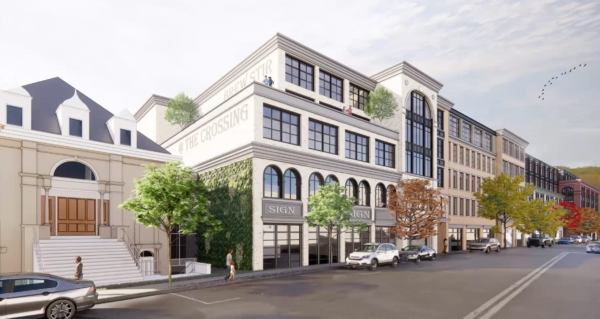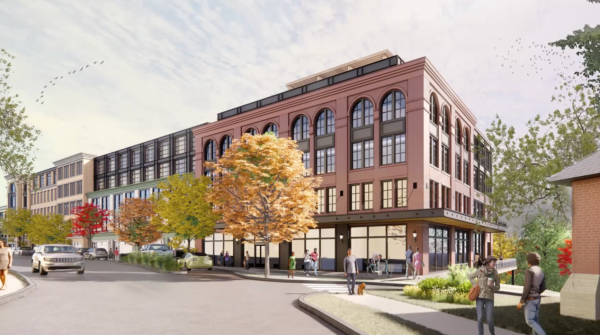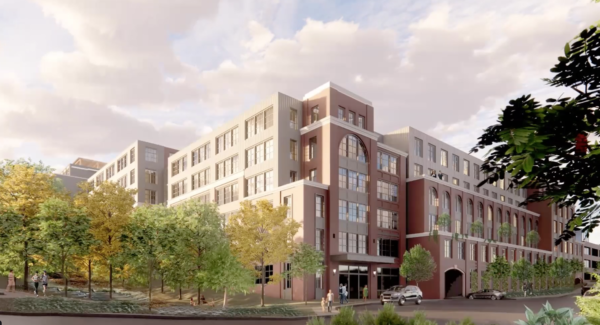Mixed-use iPark project would change downtown Brewster
National Resources wants to bring its iPark brand to the Village of Brewster, just over the border from Westchester in Putnam County and only about 10 minutes from Danbury, Connecticut. Greenwich-based National Resources has made the name iPark well known through projects in the Hudson Valley, Long Island and Norwalk. For example, the new Lionsgate movie studio in Yonkers is at iPark Hudson in the vicinity of the downtown train station and waterfront.

National Resources though iPark Brewster LLC has been selected by the Village of Brewster to be the master developer for its “Urban Renewal Plan for the Brewster Urban Renewal Area.” iPark has proposed building what’s known as Brewster Crossings on a 5.4 acres near the Metro-North Harlem Line train station. The parcels making up the site have frontage on Main Street, Railroad Avenue and Marvin Avenue. The Brewster Public Library is adjacent to the site on the eastern side.
The village’s planning board takes up the proposal again at a Dec. 21 continued public hearing.

Brewster Crossings would have 408 rental apartments and residential lofts, 11,000 square feet of street level retail space, a garage with 500 spaces and an 18,000-square-foot municipal building for offices and courts. A layout dated Aug. 6, 2021, showed three buildings that tied together on the western side as well as a brewery and lofts building on the east. The buildings would primarily be five stories in height with a concrete podium base and wood construction above.
According to documents filed with the village, the construction would be stepped in height to help deal with sloping topography in which the Main Street frontage is at an elevation of 390 feet and the Marvin Avenue side of the project is at 350 feet, a grade change of 40 feet.
Efforts to revitalize the village’s downtown are far from being new. A 2013 “Envision Brewster” report identified the village as “a hidden gem with a very diverse community” that had “all the ingredients and potential to become a vibrant Main Street and downtown.”
In 2015, Brewster’s Board of Trustees adopted a Blight Study that identified the core area of the village as blighted. In 2016, an Urban Renewal Plan was adopted and a redevelopment plan was prepared by a master developer that preceded iPark, Covington Development LLC. Covington’s plan called for fewer apartments but almost three times the retail space.
Brewster applied to New York state to be considered for a 2019 Downtown Revitalization Initiative Grant. The competition offered $10 million in funding for municipal projects. Brewster was not selected to receive funding.

“The Village believes it is necessary to create a focal point in the Village, a central gathering place, or something that will entice, encourage and effectuate the Village to become a tourist destination,” Brewster said in its application. “The residents are also concerned with traffic congestion in the Village, the poor condition of its sidewalks and the overall lack of parking. There is strong community support for improving the aesthetics and connectivity of the Village.”
“In the interim period, six years, we have watched the progress that has been made on Envision Brewster,” Lynne Ward, executive vice president of National Resources said. “The time is right now for the realization of that Envision Brewster vision that was put in place a long time ago.”
Ward said that when National Resources goes into a project it creates sets of criteria for various aspects of the development.
“One of them is to pick a well-located site, which is in close proximity to public transportation; where there is infrastructure in place but most importantly where there is a community that wants redevelopment,” Ward said. “Those criteria in our opinion are clearly met here and that means that this project for us is a ‘go.’ We think the time is right to do so now and that’s why we have done all the homework.”
Rebecca Hopkins, an architect with Tecton Architects, which is based in Hartford, said there are a number of what what she described as opportunities for Brewster. These included:
- Enhancing Main Street by making it a walkable and active street;
- Creating a strong pedestrian link from the train station to downtown destinations and parking, including access to the library and Southeast Museum;
- Linking all existing green destinations and trails;
- Revitalizing the arts, music, library and museum and creating lofts that can be used to attract artists to town;
- Connecting and centralizing public services by creating a municipal office building and court;
- Enhancing the residential lifestyle in the area by providing courtyards, patios, outdoor amenities and rooftop lounges;
- Engaging the public with outdoor cafes and outdoor patio spaces;
- Providing greater connectivity with main points of entry that are clear and defined and ease of access for vehicles, deliveries and services.
“We know the arts is a great way to really bring in some freshness, some newness using legacy pieces like the Southeast Museum, using that as an anchor to your Main Street and then expanding and sustaining an arts scene,” said Ernest Nepomuceno of Tecton. “Imagine new coffee shops, curios, ‘ma and pa’ shops that really revitalize and enhance that activity along Main Street; nightlife after the last train comes.”
The developer plans to provide vehicle and pedestrian improvements at Railroad Avenue and Main Street. These would include signal modification, upgraded sidewalks for connectivity and compliance with the Americans with Disabilities Act. The state’s Department of Transportation has control over Main Street while Railroad Avenue is a Putnam County road. The developer plans to coordinate with both the state and county on traffic matters.
Because the project is in an urban renewal area, Brewster could step in and use eminent domain proceedings to take properties for redevelopment that the developer was unable to buy from the current owners on its own.